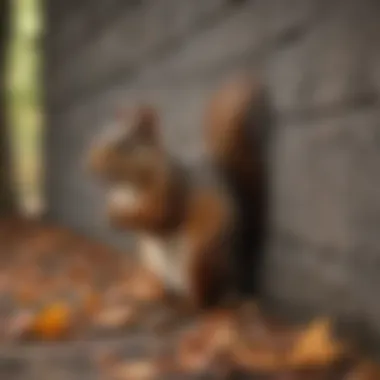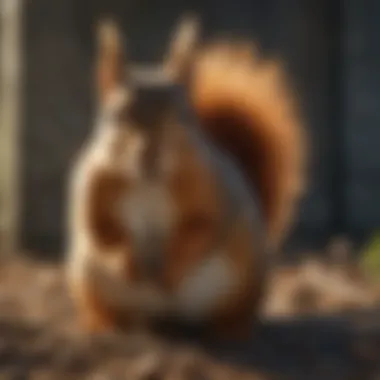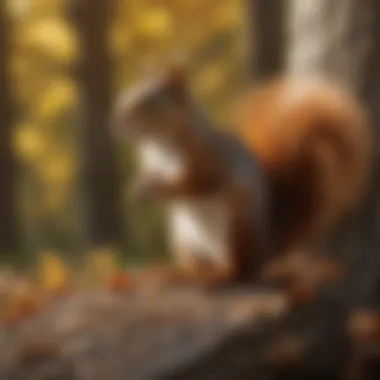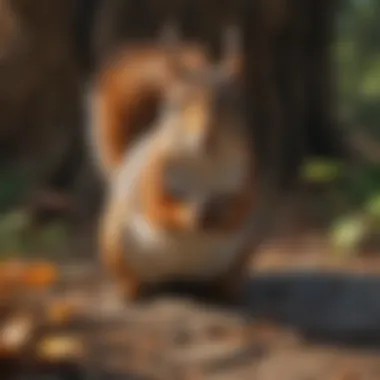Effective Strategies to Remove Squirrels from Walls


Intro
Squirrels can be more than just playful critters in your backyard; they can also become unwelcome guests within the walls of your home. Not only do they create nests, but their presence can lead to significant property damage and health risks. Understanding these furry nuisances is essential for any homeowner seeking to maintain a safe and comfortable living environment.
This article delves into effective strategies for identifying, preventing, and eliminating squirrels from wall spaces. By exploring their behavior, lifecycle, and the risks they pose, you will be equipped with valuable knowledge to tackle this issue head-on. We will also analyze eco-friendly removal techniques, focusing on methods that are both humane and respectful of the environment.
Prologue to Squirrel Infestations
In order to effectively deal with squirrel infestations, one must first understand the full scope of these issues. Squirrels can be charming creatures in their natural habitat, but when they invade human spaces, they pose various challenges. Understanding their behavior, signs of their presence, and the implications of their infestation can be crucial for homeowners. This section will elaborate on the elements that define squirrel infestations and their relevance.
Understanding Squirrel Behavior
Squirrels are known for their adaptability and cleverness. They tend to seek shelter and food, which often leads them to residential properties. They are particularly active during the daytime. Squirrels communicate through vocalizations and tail movements. Knowing their behavior can help in identifying times when they are more likely to invade homes. Their activity in the warmer months peaks as they prepare for winter, increasing the need for vigilance.
Signs of Squirrel Infestation
Identifying a squirrel infestation early can prevent extensive damage and costly repairs. Certain signs indicate their presence and allow homeowners to take action.
Scratching sounds
One of the most distinct indicators of a squirrel infestation is the scratching sounds within wall spaces. These sounds are often associated with their activity during the early morning or late evening hours. The sounds can vary in intensity and frequency. If homeowners hear unusual noises emanating from walls or attics, it may signify that they have a squirrel problem.
Their nimble nature allows them to navigate tight spaces, making it difficult to locate them. Early recognition of these sounds can prompt homeowners to investigate further, which is essential to halt any potential damage before it worsens.
Nesting materials
Squirrels often collect nesting materials such as leaves, twigs, and even insulation. These materials enable them to create comfortable nesting spaces in wall cavities or attics. If homeowners notice shredded paper or debris near entry points, it can be a clear indication of squirrel activity. This sign highlights a squirrel's attempt to establish a home within your own.
Identifying these materials helps in understanding the extent of their nesting and may guide removal efforts. Additionally, it reinforces the need to secure any vulnerable areas to deter further nesting activities.
Chewed wires and insulation
Another alarming sign is the presence of chewed wires and insulation. Squirrels possess strong teeth that facilitate their gnawing behavior. This can lead to significant damage in homes, particularly affecting electrical systems, which poses fire hazards. When homeowners observe wires with bite marks or insulation that appears to be missing, it can signal a squirrel infestation.
This issue not only impacts the safety of the home but can also lead to expensive repairs. Monitoring for this sign is essential for understanding the seriousness of the infestation and determining the next steps for removal.
By recognizing these signs, homeowners can take prompt action, preventing further deterioration of their living spaces and enhancing overall home safety.
Potential Risks of Squirrel Infestation
Understanding the potential risks of squirrel infestation is crucial for homeowners and property managers. Squirrels may seem harmless, but their presence in wall spaces can lead to significant issues. Ignoring these risks could result in costly repairs and health concerns. This section will explore structural damage and health hazards associated with squirrel infestations, which are central to recognizing the urgency of this matter.
Structural Damage
Impact on walls and insulation
Squirrels can cause substantial damage to walls and insulation. Their natural instinct to gnaw can lead to holes in the walls, allowing moisture and air infiltration. This not only compromises the integrity of the building but also increases energy costs. One key characteristic of this damage is its cumulative nature; small breaches can escalate into major repairs over time. The unique feature of this type of damage is that it often goes unnoticed until the repairs become urgent and expensive. The advantages of understanding this risk include proactive prevention, which can save homeowners significant sums in repair costs.
Entry points for other pests
Squirrels create entry points in buildings, which can be an invitation for other pests. When they gnaw through walls, they leave openings for rodents, insects, and even larger animals. The importance of addressing this aspect lies in the multiplication of pest-related complications. Once additional pests find their way in, the problem can quickly expand, requiring more extensive intervention. A notable feature of these entry points is that they may not be easily visible, making regular inspections essential. The advantage in recognizing this risk is that securing entry points can help maintain a pest-free environment.


Health Hazards
Squirrel infestations are not only structural nuisances but also pose health risks to inhabitants. Understanding these health hazards is essential for safeguarding family well-being and ensuring a safe living environment.
Transmission of diseases
Squirrels can carry pathogens that may lead to diseases transmissible to humans. For instance, they can host parasites like fleas and ticks, which pose additional risks. This particular health risk is significant because it highlights the indirect yet dangerous pathways through which diseases can spread. The unique feature of these diseases is their often subtle onset. Individuals might not realize they have been affected until symptoms present, thus emphasizing the need for preventive measures. Recognizing the transmission of diseases is beneficial in prompting timely action before infections can take hold.
Allergens from droppings
The droppings produced by squirrels can become allergens, posing a risk, especially for individuals with respiratory issues. Inhaling particles from droppings can exacerbate asthma or allergy symptoms. This aspect highlights how contamination can occur without direct contact with the animals themselves. The unique characteristic of these allergens is their persistence in the environment, remaining long after the infestation is dealt with. One important advantage of understanding this risk is that it can motivate homeowners to remain vigilant about cleanliness and regular maintenance.
"Taking preventive action against squirrel infestations is both a smart economic decision and a necessary health measure."
Preventive Measures Against Squirrels
Preventive measures against squirrels are crucial for maintaining a safe and healthy home environment. By taking proactive steps, homeowners can significantly reduce the likelihood of these creatures encountering their living spaces. This not only mitigates the risks of structural damage and health hazards but also fosters a more harmonious relationship between humans and wildlife. Preventive strategies can be economical, as they often require less financial investment compared to post-infestation removal efforts.
Sealing Entry Points
Identifying vulnerable areas
Identifying vulnerable areas is a vital step in preventing squirrel infestations. Squirrels are agile creatures, capable of accessing various entry points around a home. Common areas include gaps around vents, pipes, and foundations. Regular inspections can help pinpoint these vulnerabilities before they become problematic.
The key characteristic of identifying fr vulnerable areas lies in the thoroughness of the inspection. This practice is popular because it offers a direct way to block potential entry before squirrels can access your home. By taking the time to explore potential points of entry, homeowners can effectively safeguard their spaces.
A unique feature of this process is that it involves both the interior and exterior assessments. Not all vulnerabilities are visible from the outside. Some areas may require climbing, inspecting attics, or examining basements. The advantage is a comprehensive approach to prevention, while the downside could be the effort and time investment needed for a detailed inspection.
Choosing appropriate materials
Choosing appropriate materials for sealing entry points greatly influences the effectiveness of prevention strategies. Various sealants, such as metal mesh or caulk, can be expertly applied to deter squirrels. These materials serve as barriers against their entry and can be applied with relative ease.
The key characteristic of selecting suitable materials is their durability. Using high-quality materials creates long-term solutions and is a popular choice for those wanting to ensure thorough protection against infestations. The unique features include weather resistance and the ability to withstand gnawing, a common behavior for squirrels.
However, it is essential to acknowledge that not all materials perform equally in every scenario. Some options may require regular monitoring or maintenance, thus presenting a potential disadvantage in terms of effort for the homeowner.
Creating an Uninviting Environment
Removing food sources around the home
Removing food sources around the home is another effective preventive measure against squirrels. These creatures are opportunistic feeders and will take advantage of easily accessible food. Ensuring that pet food, bird seed, and even fallen fruits are cleared regularly can discourage them from intruding.
The key characteristic of this strategy is its simplicity. By eliminating food sources, homeowners can make their properties less appealing to squirrels, making this a beneficial choice for anyone looking to prevent infestations.
This method provides the unique benefit of not only keeping squirrels away but also attracting fewer pests overall. Nonetheless, the challenge lies in consistent maintenance to ensure that remnants of potential food sources do not accumulate over time.
Maintaining clean garden areas
Maintaining clean garden areas contributes significantly to creating an uninviting environment. Overgrown shrubs, discarded leaves, or unharvested fruits can attract squirrels to a property. Regularly trimming plants and removing debris can thus help in deterring these animals.
A key characteristic of this practice is its influence on overall landscape aesthetics and health. This makes it a popular practice for homeowners looking to maintain their gardens while also preventing infestations. The unique feature includes enhancing the appearance and health of the garden, creating a better environment for plants to thrive.
However, this approach may demand extra time and effort. Homeowners should be prepared to dedicate time to garden maintenance. While it may seem tedious, this practice has long-lasting benefits, contributing to both pest prevention and garden health.


Humane Removal Techniques
Using humane removal techniques is a crucial aspect of managing squirrel infestations. These methods provide a way to control and eliminate the problem while ensuring the animals are treated ethically. Homeowners often face a dilemma when dealing with wildlife, but humane approaches prioritize the welfare of the animals while seeking to resolve the issue. By incorporating humane strategies, residents can maintain a harmonious environment and prevent future infestations.
Live Trapping Methods
Selecting appropriate traps
Choosing the right traps is essential for effective live trapping. The traps must be sturdy and large enough to safely capture squirrels without harming them. One popular option is the Havahart live trap, known for its reliable design. Its key characteristic is a sensitive trigger mechanism that ensures the trap activates quickly, minimizing the time the squirrel spends inside.
The unique feature of these traps is that they allow for humane capture, enabling the safe relocation of the animal. Despite being a beneficial choice, residents must ensure that the trap is checked frequently to prevent stress to the captured animal. Failure to do so can lead to dehydration or unnecessary suffering, which contradicts the goal of humane treatment.
Proper baiting techniques
Proper baiting techniques play a significant role in the success of live trapping. A common practice is to use appealing food items such as peanut butter, nuts, or sunflower seeds. The key characteristic of effective baiting is the ability to entice the squirrel into the trap without triggering it prematurely.
Using the right bait not only increases the chances of catching the squirrel but also ensures the trap remains a humane option. However, baiting requires careful placement within the trap to minimize the risk of other animals getting caught and to maximize the efficiency of the trap. Improper baiting can result in wasted effort and potentially stressful situations for other creatures.
Relocation Practices
Choosing suitable release sites
Selecting appropriate release sites is vital for the success of humane squirrel removal efforts. Ideally, these sites should be located at least several miles away from the original trap location to prevent the squirrels from returning. A suitable site includes areas with sufficient food and shelter, such as wooded parks or nature reserves.
The importance of choosing the right site cannot be overstated. A poor choice might result in the squirrels struggling to survive, which would counteract the objectives of humane removal. This idea establishes a balance between managing the squirrel population and respecting wildlife needs.
Legal considerations for relocation
Understanding the legal considerations for squirrel relocation is crucial for homeowners. In many areas, local wildlife laws regulate the relocation of animals. These laws often require a permit or some level of oversight to ensure proper practices are followed.
The key characteristic of these legal guidelines is that they aim to protect both the animal and the ecosystem. Legal considerations provide a framework that ensures humane treatment is upheld during the removal process. Knowledge about these regulations is essential to avoid penalties and ensure that the actions taken are lawful, safeguarding broader community interests.
Alternative Removal Strategies
Addressing squirrel infestations within wall spaces requires a carefully crafted approach, especially for homeowners seeking alternatives to trapping or killing. Alternative removal strategies can effectively deter squirrels from establishing nests and can be more sustainable. These methods often focus on repelling the animals rather than eliminating them entirely, allowing for peaceful coexistence wherever possible. Using both chemical and natural deterrents, these strategies offer a means to manage infestations while minimizing harm to the environment.
Chemical Repellents
Types of chemical repellents
Chemical repellents come in various formulations designed to deter squirrels. Many products utilize active ingredients like capsaicin, which is derived from chili peppers. This ingredient is known for its strong, pungent aroma that squirrels find repulsive. Another common type includes ammonia-based products that emit a sharp scent, discouraging squirrels from approaching treated areas.
These repellents are popular choices for homeowners seeking quick and effective solutions. Their key characteristic lies in their volatility; they often evaporate quickly, which means that they may need frequent reapplication. However, they can be quite effective when applied correctly, particularly in areas where squirrels are known to enter or nest. They create a barrier, making spaces less inviting.
Application methods and safety
For proper application, it is vital to follow the manufacturer’s instructions closely. Chemical repellents should be applied strategically, focusing on entry points such as cracks and crevices in walls or around decks. Additionally, it’s crucial to consider safety precautions. Many chemical repellents can be harmful if inhaled or ingested, especially for children and pets. Using gloves during application and ensuring adequate ventilation can reduce potential health risks.
While effective, one should remember that overuse can lead to environmental concerns. Therefore, monitoring the effectiveness of the repellents and avoiding excessive application is advisable.
Natural Deterrents


Essential oils and their effectiveness
Natural deterrents have gained popularity among homeowners who prefer eco-friendly solutions. Essential oils, such as peppermint and citrus oils, are noted for their effectiveness in repelling squirrels. The strong scent of these oils can mask familiar odors that attract squirrels to certain areas.
These oils are often used in sprays or diffusers placed around nests or potential entry points. The unique feature of essential oils is that they are generally safe for the environment and non-toxic to humans and pets, making them an attractive option for families. However, their effectiveness may diminish over time or in extreme weather conditions, necessitating regular reapplication.
Plant-based solutions
Another avenue for natural deterrents includes using certain plants. Some species, such as garlic and marigolds, are known to repel squirrels. Planting these around your home can serve as a natural barrier. The strong scents and compounds released by these plants deter pests.
This method is particularly beneficial because it not only helps manage squirrel populations but also enhances the garden's aesthetic. Nonetheless, there are downsides, such as the time it takes for plants to mature and the potential need for ongoing maintenance.
When to Seek Professional Help
Recognizing when to seek professional help is paramount in dealing with squirrel infestations. Homeowners may feel they can handle minor issues independently. However, certain situations demand expert intervention. This section will highlight key indicators that suggest it's time to call in professionals.
Squirrels can cause considerable damage to your home if their presence is not addressed properly. Their nesting habits can compromise the structural integrity of walls and insulation. Thus, understanding the signs of a severe infestation is crucial.
Recognizing Severe Infestations
Severe infestations can often go unnoticed until significant damage occurs. Homeowners should be vigilant for several tell-tale signs that indicate a worrying presence of squirrels within the walls:
- Persistent Noises: Frequent scratching, scurrying, or chattering sounds coming from the walls can be a clear indication of squirrels nesting.
- Visible Damage: Look for signs of gnawing at the edges of wooden structures or marks left behind from ongoing activity. This can include chewed insulation material and shredded paper or fabric.
- Droppings: Finding squirrel droppings around your home is a strong indicator of their presence. The feces are often small, dark, and can resemble miniature rabbit droppings.
If you notice any combination of these signs, it is advisable to seek professional help promptly.
Choosing a Pest Control Expert
Choosing the right pest control expert can greatly influence the outcome of squirrel removal. Not all pest control professionals are the same, so it's essential to select one with appropriate experience and knowledge.
Credentials to consider
When evaluating pest control experts, consider their credentials. It is important to look for a license specific to pest control in your area. A licensed professional has completed a rigorous program and understands both the legal and safety measures essential for effective pest management. They are also typically insured, which protects you from liability in case of accidents.
The key characteristic of a good pest control expert is their track record. Look for professionals with strong reviews or references. This ensures they have successfully handled similar squirrel issues in the past. The unique feature lies in their familiarity with humane removal techniques and local wildlife laws, adding a level of trustworthiness in their approach.
Questions to ask potential contractors
Before hiring, it's crucial to ask potential contractors specific questions. This allows you to assess their capability adequately. Key questions might include:
- What methods do you use for squirrel removal? It's important to know whether they employ humane practices or more aggressive methods.
- Can you provide references from previous clients? This can give insight into their success rate and reliability.
- Do you offer a guarantee on your work? A guarantee often indicates confidence in their methods.
The key characteristic of asking questions lies in establishing clarity. A competent contractor will be transparent and able to explain their approach to pest management. The unique feature of this dialogue is that it fosters trust between the homeowner and the service provider. This clear communication can also help minimize any misunderstandings during the process.
Culmination
Understanding the importance of managing squirrel infestations within residential spaces cannot be overstated. Squirrels, while often perceived as cute creatures, can cause significant damage and health risks when they choose to nest in the walls of homes. This article has highlighted various aspects related to effective strategies that can be employed to eliminate them from such environments.
Recap of Effective Strategies
To sum up, several approaches have been discussed:
- Identification of Signs: Recognizing signs of infestation, such as scratching sounds and nesting materials, is essential. Prompt action can prevent further complications.
- Preventive Measures: Sealing entry points and creating an uninviting environment can reduce the likelihood of squirrel invasion. Maintaining cleanliness and removing potential food sources around the home is crucial.
- Humane Removal Techniques: Employing live trapping and proper relocation methods ensure that suffering is minimized. Understanding humane practices maintains ethical standards while addressing the problem.
- Alternative Removal Strategies: Utilizing chemical repellents and natural deterrents offers multiple avenues for eviction. Knowledge of various products ensures informed choices.
- Recognizing When to Seek Professional Help: Severe infestations may require expert intervention. Knowing what credentials to look for can aid in selecting the right pest control expert.
Encouraging Responsible Practices
Encouraging responsible practices not only protects one’s home but also promotes a balanced ecosystem. It is vital that homeowners adopt ethical approaches when dealing with wildlife issues.
- Environmental Awareness: Remain informed about the impact of removal strategies on local wildlife. Non-lethal methods are preferable and should be prioritized whenever possible.
- Community Responsibility: Engage with neighbors to promote an awareness of squirrel management techniques that everyone can use collectively. This also reinforces a shared neighborhood responsibility toward wildlife.
- Legal Considerations: Various regions have regulations regarding animal control. Ensure compliance with local laws to avoid legal repercussions.







